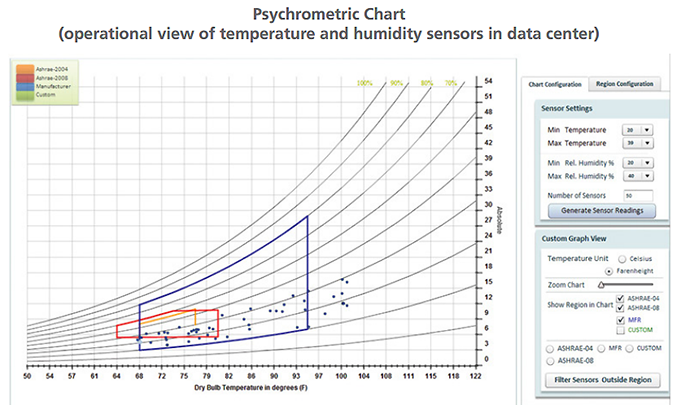The Raritan Blog
Home » Raritan Blog » Data Center Airside Economizers and Humidity
Data Center Airside Economizers and Humidity
Greg More
December 10, 2013

The American Society of Heating, Refrigeration and Air-Conditioning Engineers (ASHRAE) publishes recommended ranges for temperature (65 degrees to 80 degrees F, 18 degrees to 27 degrees C) and relative humidity (20% to 80%).
One of the best ways to understand the relationship between temperature and humidity is to look at a psychrometric chart. The bottom of the chart is dry bulb temperature meaning air containing no moisture. The scale on the right of the chart is the amount of moisture in pounds contained in a pound of dry air. The curves running through the chart are the relative humidity (RH) from 0% to 100%. The temperature scale along the 100% RH curve is the wet bulb temperature.
100% RH is the maximum amount of moisture the air can contain. Beyond this point, the dew point (DP), the excess moisture condenses into droplets. The height of the chart increases from left to right. This is because colder air can hold less moisture than warmer air.
If you fill a glass with ice water on a warm summer day, condensation forms on the glass. This is because the air at the surface of the glass has cooled from say 75 degrees F down to just above freezing at the surface of the glass. If the 75 degree F air had a RH of 50% that would be 0.019 pounds of moisture per pound of air. But, at 32 degrees F air saturates (100% RH) at 0.004 pounds of moisture per pound of air. The excess moisture (0.019 – 0.004) becomes the condensation on the glass.
Data centers using airside economizers need to think about adding humidification because the cool outside air, say 40 degrees F and 50% RH with is approximately 0.003 pounds of moisture, comes into the data center and is then warmed by IT equipment to say 80 degrees F. 0.003 pounds of moisture at 80 degrees F is less than 15% RH which is below the ASHRAE recommendation of at least 20% RH to minimize electrostatic discharge (ESD).
Click here to read the Entire Environmental Monitoring White Paper
Other Blog Posts
- The Rapid Growth of AI and the Use of Raritan PDUs to Meet Higher Power Demands
- Posted on October 11, 2023
- Data Center Report Fewer Outages, But Downtime Still Costly
- Posted on September 20, 2023
- Survey: Energy Usage and Staffing Shortages Challenge Data Centers
- Posted on September 20, 2023
- Raritan Secure Switch: Secure NIAP 4.0 Compliant Desktop KVM
- Posted on September 20, 2023
- The Midwest is a Hot Market for Data Centers: How the New Generation of Intelligent Rack PDUs Can Save Cloud Giants Uptime and Money
- Posted on September 7, 2023
Subscribe
Upcoming Events
- Advancing Data Center Construction West 2024
- May 6 – 8 • Salt Lake City, UT
- Net Zero Data Center
- May 16 – 17 • Dallas, TX
- 7x24 Exchange Spring
- June 9th • JW Marriott Orlando Grande Lakes
Latest Raritan News
- Legrand Certifications and Process Controls Provide Confidence in Information Security for Network-Connected Devices in Data-Related Applications
- Posted on April 1, 2024
- Legrand Releases Version 4.0 of Raritan’s Industry-Leading Secure KVM Switches, Raising Bar for Secure Desktop Access
- Posted on July 31, 2023
- Legrand Revitalizes Data Center Sector with Two Revolutionary Intelligent Rack PDUs
- Posted on May 1, 2023
- Raritan Reveals The MasterConsole® Digital Dual KVM Switch
- Posted on February 18, 2021
- Legrand Data, Power and Control Division Announced as Finalist in Six Categories at DCS Awards 2020
- Posted on November 9, 2020